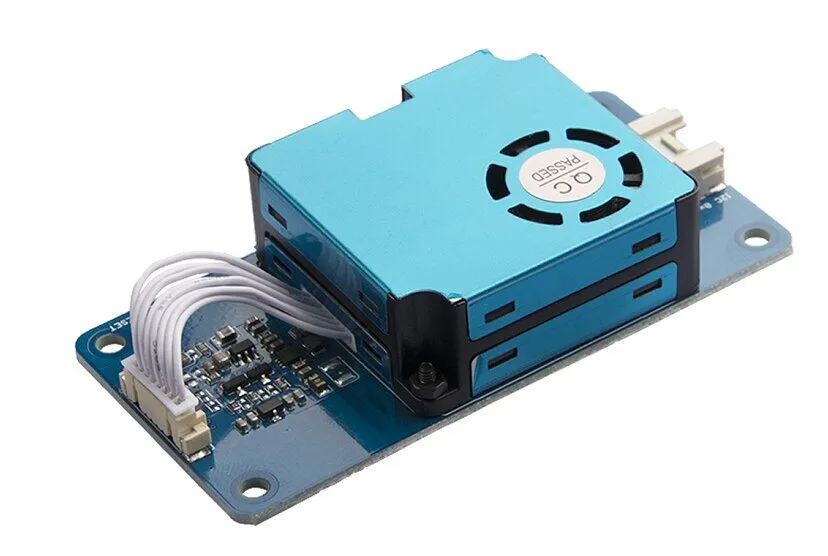On this page
As air quality becomes an increasing concern globally, PM2.5 sensors play a crucial role in monitoring particulate matter, allowing individuals, businesses, and governments to take action for healthier environments. Particulate matter, specifically PM2.5, refers to fine particles that are 2.5 micrometers in diameter or smaller. Due to their tiny size, these particles can penetrate deep into the lungs and even enter the bloodstream, potentially causing respiratory and cardiovascular problems, particularly in children, the elderly, and those with preexisting health conditions.
This article explores the fundamentals of PM2.5 sensors, how they work, and tips for selecting the right one to help you stay informed about the air you breathe.
The sensor works by pulling in ambient air and using light scattering or laser-based technology to detect particles. Once the particles pass through a laser beam within the sensor, the device measures the size and quantity of each particle based on how much light is scattered. The resulting data is then translated into the concentration of PM2.5 in the air, measured in micrograms per cubic meter (μg/m³). PM2.5 levels are often displayed on an accompanying screen or transmitted to connected devices for easy monitoring.
This article explores the fundamentals of PM2.5 sensors, how they work, and tips for selecting the right one to help you stay informed about the air you breathe.

The sensor works by pulling in ambient air and using light scattering or laser-based technology to detect particles. Once the particles pass through a laser beam within the sensor, the device measures the size and quantity of each particle based on how much light is scattered. The resulting data is then translated into the concentration of PM2.5 in the air, measured in micrograms per cubic meter (μg/m³). PM2.5 levels are often displayed on an accompanying screen or transmitted to connected devices for easy monitoring.

The sensor has a built-in fan or a similar mechanism that draws in a sample of ambient air, directing it through the sensor's detection chamber.
Once inside, the air sample is exposed to a laser beam or an infrared light. As particles pass through the light, they scatter it at specific angles depending on their size and shape.
The scattered light is detected by a photodetector, which converts it into an electrical signal. This signal is then analyzed to determine the number and size of particles in the air sample.
The sensor’s processor calculates the concentration of PM2.5 particles per cubic meter. This value is typically displayed in real-time on a screen or sent to an external display or device for monitoring.
PM2.5 sensors are designed to provide accurate data with a high degree of sensitivity, allowing users to monitor even small changes in air quality. Some advanced models can distinguish between different particle sizes, offering data on PM10 or smaller particles as well.
PM2.5 sensors are designed to provide accurate data with a high degree of sensitivity, allowing users to monitor even small changes in air quality. Some advanced models can distinguish between different particle sizes, offering data on PM10 or smaller particles as well.
When it comes to selecting a PM2.5 sensor, there are several important factors to consider, especially if you’re looking for accuracy, durability, and ease of use:
The accuracy of a PM2.5 sensor is paramount, as it determines the reliability of the air quality data you’ll receive. Look for sensors with proven accuracy, often validated by third-party certifications or testing standards. The best sensors provide data within a small margin of error, offering both high sensitivity and precise measurements.
PM2.5 sensors generally use either laser scattering or infrared light to detect particles. Laser-based sensors are often more accurate and sensitive, making them suitable for applications requiring high precision. Infrared sensors, while less sensitive, can still provide valuable data and are typically more affordable. Choose a sensor based on your specific needs—whether it’s detailed monitoring or general air quality awareness.
In an increasingly digital world, many PM2.5 sensors come with connectivity options such as Wi-Fi or Bluetooth. These sensors can link with smartphones, tablets, or computer applications, allowing you to track air quality data remotely. Connectivity also enables long-term data storage, which can be helpful for analyzing trends and changes in air quality over time.
PM2.5 sensors can be powered by batteries, USB, or direct power sources. For portable sensors, battery life is a crucial factor, as it determines how long the sensor can run between charges. In contrast, stationary sensors typically use wired power, which allows continuous operation. Choose a sensor with a power source that fits your intended usage, whether portable for on-the-go measurements or fixed for consistent, long-term monitoring.
For outdoor use, select a sensor that is weatherproof or resistant to environmental elements like dust, humidity, and extreme temperatures. A robust build ensures that the sensor maintains accuracy and functionality even in challenging conditions. Indoor sensors may not require the same level of durability but should still be made from high-quality materials to avoid wear and tear.
PM2.5 sensors range widely in price, depending on factors like accuracy, features, and brand reputation. High-end sensors with advanced features will come at a premium, but for those seeking a general awareness of air quality, budget-friendly options are available. Weigh the cost against the sensor’s features to determine the best option for your needs.
PM2.5 sensors are indispensable tools for anyone concerned about air quality. They provide critical real-time data on particulate matter concentrations, enabling people to make informed decisions to protect their health. Understanding how these sensors work, as well as knowing what to look for when choosing one, can help you find a suitable model for personal or professional use. Whether you’re monitoring air quality at home, in an office, or in an industrial setting, PM2.5 sensors provide a reliable way to keep track of airborne pollutants.
As awareness of air quality grows, PM2.5 sensors are becoming more accessible and essential, empowering people to take control of the air they breathe. By investing in a quality sensor and following best practices for its use, you can contribute to creating healthier environments for yourself and those around you.
As awareness of air quality grows, PM2.5 sensors are becoming more accessible and essential, empowering people to take control of the air they breathe. By investing in a quality sensor and following best practices for its use, you can contribute to creating healthier environments for yourself and those around you.
Previous: Formaldehyde: What You Need to Know to Protect Your Health
Next: Smart Air Quality Monitors: Enhancing Indoor Air for Healthier Living




